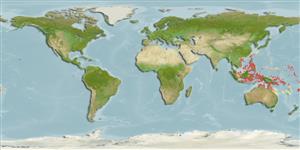>
Blenniiformes (Blennies) >
Blenniidae (Combtooth blennies) > Salariinae
Etymology: Ecsenius: Greek, exenios, -os, -on = uncontrolled, immoderate.
Environment: milieu / climate zone / depth range / distribution range
Ökologie
seewasser riff-verbunden; standorttreu; tiefenbereich 2 - 10 m (Ref. 90102). Tropical
Western Central Pacific: known only from the small islands in the Moluccas, New Guinea and eastward to Florida Island, Solomon Islands.
Size / Gewicht / Alter
Maturity: Lm ? range ? - ? cm
Max length : 3.0 cm TL Männchen/unbestimmt; (Ref. 48636)
Kurzbeschreibung
Morphologie | Morphometrie
Distinctive species, easily identified by the thin dark lines and bright white spots. The Bali specimens are generally paler and have smaller white spots than those from Flores and Sangihe Islands but this maybe habitat related (Ref. 48636).
Adults are found solitary or in small groups perched on corals, sponges, and tunicates (Ref. 90102) in coastal reef crests (Ref. 8631, 48636). Oviparous. Eggs are demersal and adhesive (Ref. 205), and are attached to the substrate via a filamentous, adhesive pad or pedestal (Ref. 94114). Larvae are planktonic, often found in shallow, coastal waters (Ref. 94114).
Life cycle and mating behavior
Geschlechtsreife | Fortpflanzung | Ablaichen | Eier | Fecundity | Larven
Oviparous, distinct pairing (Ref. 205).
Springer, V.G., 1988. The Indo-Pacific blenniid fish genus Ecsenius. Smithson. Contrib. Zool. (465):134 p. (Ref. 5296)
IUCN Rote Liste Status (Ref. 130435)
Bedrohung für Menschen
Harmless
Nutzung durch Menschen
Fischereien: nicht kommerziell; Aquarium: Kommerziell
Mehr Information
ReferenzenAquakulturAquakultur ProfilZuchtlinienGenetikElectrophoresesVererbbarkeitKrankheitenVerarbeitungNutrientsMass conversion
PartnerBilderStamps, Coins Misc.LauteCiguateraGeschwindigkeitSchwimmstilKiemenoberflächeOtolithsGehirngrößeSehfähigkeit
Tools
Zusatzinformationen
Download XML
Internet Quellen
Estimates based on models
Preferred temperature (Ref.
123201): 27.1 - 29.3, mean 28.8 °C (based on 1271 cells).
Phylogenetic diversity index (Ref.
82804): PD
50 = 0.5000 [Uniqueness, from 0.5 = low to 2.0 = high].
Bayesian length-weight: a=0.00741 (0.00335 - 0.01640), b=3.02 (2.83 - 3.21), in cm total length, based on LWR estimates for this (Sub)family-body shape (Ref.
93245).
Trophic level (Ref.
69278): 2.0 ±0.00 se; based on food items.
Widerstandsfähigkeit (Ref.
120179): hoch, Verdopplung der Population dauert weniger als 15 Monate. (Preliminary K or Fecundity.).
Fishing Vulnerability (Ref.
59153): Low vulnerability (10 of 100).
Nutrients (Ref.
124155): Calcium = 423 [193, 1,079] mg/100g; Iron = 1.63 [0.79, 3.33] mg/100g; Protein = 17.6 [16.2, 19.0] %; Omega3 = 0.0894 [, ] g/100g; Selenium = 29.9 [9.7, 86.2] μg/100g; VitaminA = 98 [19, 511] μg/100g; Zinc = 5.25 [2.92, 8.46] mg/100g (wet weight);
